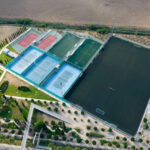When it comes to designing or upgrading a sports facility, one of the most important decisions is choosing the right flooring. Athletes rely on safe, durable, and high-performing surfaces to bring out their best performance, and that’s where the flooring choice becomes crucial. Over the years, synthetic sports flooring has gained immense popularity as an alternative to traditional flooring options like wood, concrete, or asphalt. But the big question is—which is better for athletes? Let’s break it down.
1. Performance and Comfort
Athletes spend hours practicing, training, and competing, and the surface they play on directly affects their comfort and performance. Traditional flooring, such as wooden or concrete surfaces, often lacks the shock absorption needed for high-impact sports. Wooden flooring works well for indoor games like basketball or badminton, but it’s not suitable for outdoor sports where weather and moisture can affect performance.
On the other hand, synthetic sports flooring is specifically engineered to provide excellent shock absorption and bounce. Its cushioned layers reduce strain on joints, knees, and ankles, making it ideal for intense sports like tennis, futsal, or even multi-purpose indoor arenas. Athletes not only perform better but also feel less fatigued after long training sessions.
👉 Winner: Synthetic Sports Flooring – because it supports both performance and comfort.
2. Safety and Injury Prevention
Safety is non-negotiable when it comes to athletes. Traditional flooring, especially concrete, can be harsh and lead to injuries like sprains, stress fractures, or muscle strains. Wooden floors are better but can still become slippery or uneven over time.
Meanwhile, synthetic sports flooring is designed with athlete safety in mind. It provides anti-slip surfaces, impact resistance, and even surface uniformity. Many synthetic options are certified for reducing the risk of injuries, giving athletes confidence to train harder without worrying about unnecessary accidents.
👉 Winner: Synthetic Sports Flooring – because it prioritizes safety.
3. Durability and Maintenance
Durability is another major factor when comparing synthetic and traditional flooring. Wooden floors are prone to scratches, require polishing, and may get damaged by moisture. Concrete or asphalt, while tough, can crack over time and doesn’t provide the performance quality athletes need.
Synthetic sports flooring, however, is built to withstand heavy use. Whether it’s indoor gyms, school courts, or professional sports complexes, synthetic surfaces last longer and require minimal maintenance. Simple cleaning and occasional checks are usually enough to keep them in top condition, saving both time and money in the long run.
👉 Winner: Synthetic Sports Flooring – because it offers long-term durability with low maintenance.
4. Versatility and Usage
Traditional flooring has limitations. Wooden surfaces are ideal only for indoor use, while concrete and asphalt are mostly for outdoor courts. Switching between sports often requires modifications or compromises in quality.
In contrast, synthetic sports flooring is highly versatile. It can be installed both indoors and outdoors, customized for different sports, and even used in multi-purpose halls. From basketball and volleyball to futsal and tennis, synthetic flooring adapts to different needs while ensuring consistent performance.
👉 Winner: Synthetic Sports Flooring – because of its wide adaptability.
5. Cost and Value for Money
One might argue that traditional flooring, especially concrete, is cheaper upfront. While that’s true, the long-term costs of repairs, resurfacing, and maintenance add up quickly. Wooden flooring, on the other hand, is more expensive and requires regular upkeep.
Synthetic sports flooring may seem like a bigger investment initially, but it pays off in durability, performance, and reduced maintenance costs. Over time, it becomes the more cost-effective option for schools, gyms, and professional sports facilities.
👉 Winner: Synthetic Sports Flooring – because it provides better long-term value.
Final Verdict: Which is Better for Athletes?
When comparing synthetic sports flooring vs. traditional flooring, it’s clear that synthetic options offer more benefits to athletes. From performance and safety to durability and cost-effectiveness, synthetic surfaces check all the boxes. While traditional flooring still has its place—such as classic wooden courts for basketball—synthetic flooring is emerging as the smarter choice for modern sports facilities.
Athletes deserve the best, and with synthetic sports flooring, they get a reliable, safe, and high-performing surface that enhances their training and competitive edge. If you’re planning to build or upgrade your facility, investing in synthetic sports flooring is a decision that supports both athletes and long-term value.

